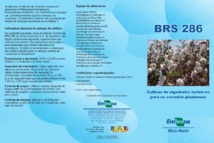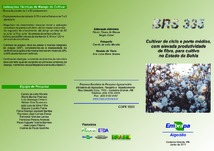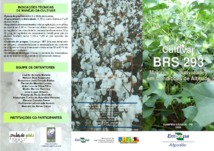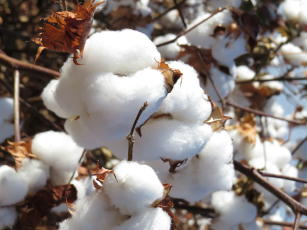Embrapa's cotton genetics crosses borders
Embrapa's cotton genetics crosses borders
Photo: Fabiano Perina

Embrapa's cotton cultivars stand out due to their excellent adaptation to tropical environments and major advances in fiber quality and resistance to main diseases
Our tropical cotton production technology has drawn attention beyond Brazil's borders. Three conventional (not GM) cotton cultivars developed by Embrapa have been certified for commercial cropping in the United States. The most recent one to be licenced by the United States Department of Agriculture (USDA) was the cultivar BRS 335.
Another two cultivars had already been registered for that use – BRS 286, in 2013, and BRS 293, in 2014. Several cotton-producing countries in Africa and Latin America have also been adopting Brazilian cotton cultivars through international cooperation projects.
Embrapa's cotton genetic improvement program has generated high-productivity and high-fiber quality cultivars that adapt well to the country's main cropping regions. The corporation's cotton cultivars stand out due to their excellent adaptation to tropical environments and major advances in fiber quality and resistance to main diseases, drought, and other environmental stresses. The program is dedicated to developing both conventional and genetically modified cultivars, the latter of which with resistance to caterpillar attacks and tolerance to glyphosate.
"The genetic gains obtained by Embrapa's cultivars are attracting the interest of other cotton-producing countries, and exporting Brazilian cultivar genetics can create business possibilities. Conventional cotton cultivars by Embrapa are being assessed in countries in West Africa, Latin America and the United States", explains the head of Embrapa Cotton (Campina Grande, Paraíba), Sebastião Barbosa.
The interest of African and Latin American countries in Brazilian countries stemmed from international cooperation project activities conducted by Embrapa in partnership with the Ministry of External Relations Brazilian Cooperation Agency and with the Food and Agriculture Organization of the United Nations (FAO), in which the corporation made their conventional cultivars available for assessment. Such projects aim at transfering Brazilian cotton production technology as a type of international aid for developing countries. In Africa, more specifically in Mali, Benin, Burkina Faso, and Chade, results have shown the successful adaptation of the cultivars BRS 293, BRS 286 and BRS Seridó.
In the United States there is also an interest for Embrapa's conventional cultivars for cultivation in specific environments, where there is lower caterpillar incidence of caterpillars and weeds are managed with the use of pre- and post-emergence herbicides. Hence some conventional cultivars are being tested in the main American cotton-producing zones, in the states of Georgia, Mississippi, Tennessee, Arkansas, and Texas, in official trials, conducted by respective universities that focus on cotton cropping (land-grant universities).
The results obtained in four cropping years of assessment revealed the excellent potential of the BRS 286, BRS 293 and BRS 335 cultivars, who are already protected by Embrapa and USDA. The studies on Embrapa's conventional cultivars in the United States have been carried out within the scope of Embrapa – International Seed Technology's technical cooperation, and IST will be responsible for the validation, market development, multiplication and trading of the seeds of such cultivars.
Translation: Mariana de Lima Medeiros
Edna Santos (MTB-CE 01700)
Embrapa Cotton
Press inquiries
algodao.imprensa@embrapa.br
Phone number: (83)3182-4361
Further information on the topic
Citizen Attention Service (SAC)
www.embrapa.br/contact-us/sac/





